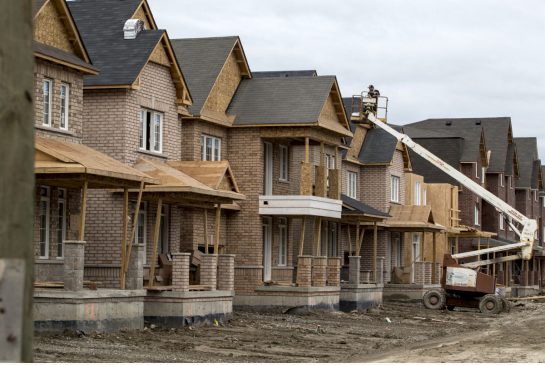Despite the Greenbelt, suburban sprawl presses on

Despite much-touted provincial regulations, dumb growth continues unabated on the ragged frontier of the megacity
By John Barber Toronto Star
Flowers will be strewn and Hosannas sung in upcoming days when elder statesman David Crombie, irrepressible bearer of good news, releases the results of his latest expert panel — a mandated review of the Ontario Greenbelt and the “smart growth” planning legislation that became law along with it a decade ago.
The panel will affirm that the Greenbelt is a great success and will likely recommend that it be expanded. Bambi will smile.
But cynics might well wonder why nothing has seemed to change on the ragged frontier of the megalopolis, where low-density, completely auto-dependent dumb growth continues as if nothing had changed. If they cared to investigate, they will discover that in fact little did change in this crucial terrain.
The Greenbelt is still too far off to impinge on the pre-planned sprawl now taking place in the suburbs surrounding Toronto. According to the Neptis Foundation, there is still enough space between the outer suburbs and the Greenbelt to accommodate a new city twice the size of Toronto. But instead of shifting to a more sustainable model for developing those lands, as mandated by provincial law, suburban municipalities are actively resisting it — demanding concessions here, exemptions there, and generally browbeating their hapless overlords at Queen’s Park about the onerous requirement to build sustainably.
Back in the real world, citizens have taken sides. The trend in favour of more diverse, walkable neighbourhoods began well before the appearance of legislation encouraging it, and it has since become a landslide. The annual number of low-density housing starts in the urban region has dropped by half since 2002, according to provincial data, while the number of apartment units built has tripled — with most of that development concentrated in the central city.
There are five times as many new condominium apartments as there are single-family homes for sale today, according to industry data. New home sales dropped almost 30 per cent over the past year, and more recently prices have begun to sag as well.
The good news is that sprawl is slowing of its own accord. The bad news is that developers and their handmaids in suburban councils still cling to the outdated model. Despite clear market trends — and a superabundance of zoned vacant land available inside the Greenbelt — homebuilders still say that provincial legislation is restricting the supply and driving up the cost of outer-fringe front doors. Parroting the view, suburban politicians insist they cannot possibly meet provincially mandated targets for intensification.
To know why that’s nonsense, one need only look a few miles west to the Regional Municipality of Waterloo, which recently adopted and successfully defended an official plan that not only meets provincially mandated targets for smart growth but exceeds them in every dimension.
Developers in Waterloo demanded that the plan give them an extra 1,053 hectares of farmland to pave. After a four-year struggle at the Ontario Municipal Board, they got a quarter of that. Suburban Toronto municipalities complain that they could never achieve a target that requires them to direct 40 per cent of new development into already built-up areas. Waterloo, one of the few growing regions in Ontario outside Toronto, is already running at 60 per cent. The region’s urban boundary is now hard-etched for a generation at least.
The main reason why other regions still cling to an outdated suburban dream is because of the new assessment and lucrative fees that sprawl provides to them. As local taxpayers know, living in the outer suburbs is already more expensive than living in a city with far more extensive services. But it will only become more expensive if there’s no more new sprawl to subsidize the old. The moment the ship is required to float on its own bottom, it will sink.
The magically self-financing form of urban development that created Greater Toronto is essentially a Ponzi scheme. But as long as more raw land continues to be fed into the hopper, the reckoning can always be put off.
The other reason they cling to the past is that it’s all they know. Suburban politicians around Toronto, along with the developers they court, have little conception of redevelopment, what it might look like and how it might come about. They’ve had a decade to adapt to the demands of the new century, but they’ve used it only to dig in their heels. Nothing exemplifies the problem better than Brampton’s recent rejection of a desperately needed new transit line.
Will Crombie’s panel be bold enough to deliver the bad news — that this nonsense has to stop? Or will it all just roll on until the last square inch of land inside the Greenbelt is paved?
John Barber is a freelance journalist. Follow him on Twitter @annegonian









Leave a Reply